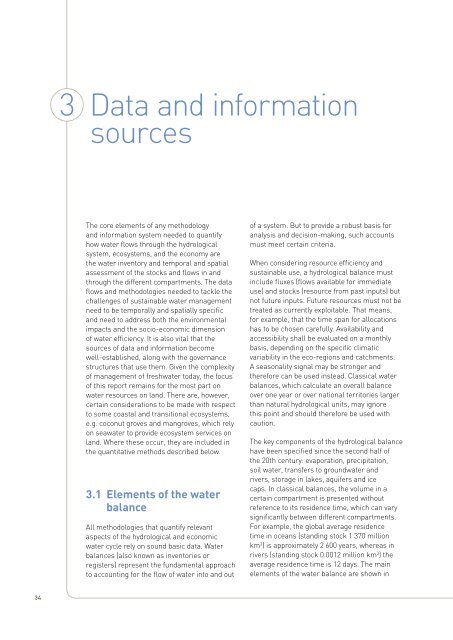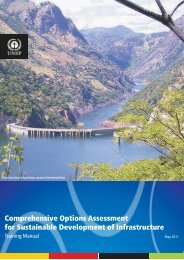MEASURING WATER USE IN A GREEN ECONOMY - UNEP
MEASURING WATER USE IN A GREEN ECONOMY - UNEP
MEASURING WATER USE IN A GREEN ECONOMY - UNEP
Create successful ePaper yourself
Turn your PDF publications into a flip-book with our unique Google optimized e-Paper software.
3 Data and information<br />
sources<br />
The core elements of any methodology<br />
and information system needed to quantify<br />
how water flows through the hydrological<br />
system, ecosystems, and the economy are<br />
the water inventory and temporal and spatial<br />
assessment of the stocks and flows in and<br />
through the different compartments. The data<br />
flows and methodologies needed to tackle the<br />
challenges of sustainable water management<br />
need to be temporally and spatially specific<br />
and need to address both the environmental<br />
impacts and the socio-economic dimension<br />
of water efficiency. It is also vital that the<br />
sources of data and information become<br />
well-established, along with the governance<br />
structures that use them. Given the complexity<br />
of management of freshwater today, the focus<br />
of this report remains for the most part on<br />
water resources on land. There are, however,<br />
certain considerations to be made with respect<br />
to some coastal and transitional ecosystems,<br />
e.g. coconut groves and mangroves, which rely<br />
on seawater to provide ecosystem services on<br />
land. Where these occur, they are included in<br />
the quantitative methods described below.<br />
3.1 Elements of the water<br />
balance<br />
All methodologies that quantify relevant<br />
aspects of the hydrological and economic<br />
water cycle rely on sound basic data. Water<br />
balances (also known as inventories or<br />
registers) represent the fundamental approach<br />
to accounting for the flow of water into and out<br />
of a system. But to provide a robust basis for<br />
analysis and decision-making, such accounts<br />
must meet certain criteria.<br />
When considering resource efficiency and<br />
sustainable use, a hydrological balance must<br />
include fluxes (flows available for immediate<br />
use) and stocks (resource from past inputs) but<br />
not future inputs. Future resources must not be<br />
treated as currently exploitable. That means,<br />
for example, that the time span for allocations<br />
has to be chosen carefully. Availability and<br />
accessibility shall be evaluated on a monthly<br />
basis, depending on the specific climatic<br />
variability in the eco-regions and catchments.<br />
A seasonality signal may be stronger and<br />
therefore can be used instead. Classical water<br />
balances, which calculate an overall balance<br />
over one year or over national territories larger<br />
than natural hydrological units, may ignore<br />
this point and should therefore be used with<br />
caution.<br />
The key components of the hydrological balance<br />
have been specified since the second half of<br />
the 20th century: evaporation, precipitation,<br />
soil water, transfers to groundwater and<br />
rivers, storage in lakes, aquifers and ice<br />
caps. In classical balances, the volume in a<br />
certain compartment is presented without<br />
reference to its residence time, which can vary<br />
significantly between different compartments.<br />
For example, the global average residence<br />
time in oceans (standing stock 1 370 million<br />
km 3 ) is approximately 2 600 years, whereas in<br />
rivers (standing stock 0.0012 million km 3 ) the<br />
average residence time is 12 days. The main<br />
elements of the water balance are shown in<br />
34

















